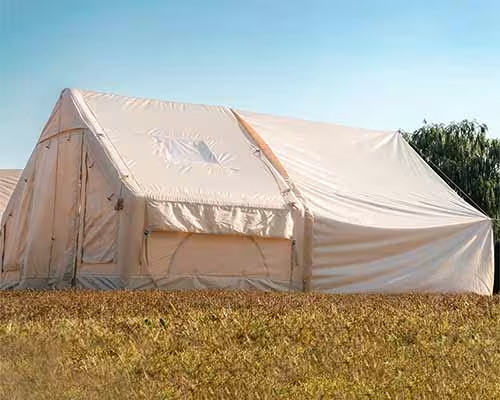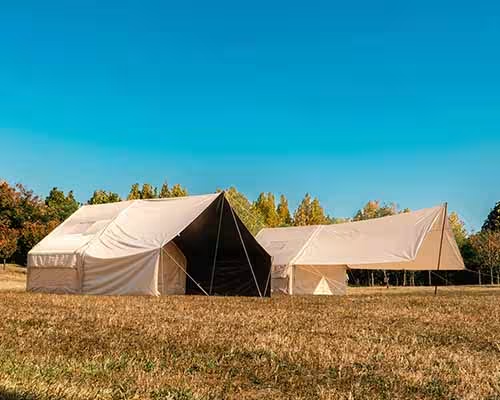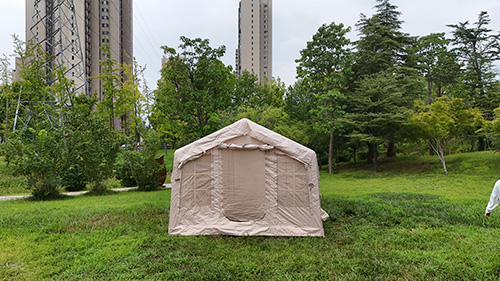Table of Contents
Introduction

When it comes to outdoor adventures, an inflatable tent can completely change the way you camp, travel, or host events. These tents are valued for their quick setup and lightweight design, but the most important aspect is safety. Without the right safety features, the convenience of an inflatable tent can quickly turn into a challenge.
At Xingyue, we understand this balance better than most. As a professional tent manufacturer, our product line includes inflatable tents, ultralight trekking tents, tunnel tents, hotel tents, aluminum pole tents, and outdoor gear. With years of experience in OEM/ODM services, we help clients worldwide create safe, reliable, and custom-designed products. This article dives into the critical safety features of inflatable tents, why they matter, and how choosing the right manufacturer ensures you get durability and peace of mind.
Why Safety Matters in an Inflatable Tent
An inflatable tent relies on air beams instead of traditional poles, which means its structural integrity depends on engineering and material quality. According to outdoor gear safety reports, tents without reinforced seams or tested pressure systems face a much higher risk of collapse in extreme weather. For families, groups, or businesses using tents for events, overlooking safety features can lead to discomfort and potential hazards.
Fire-Resistant Materials: Essential Protection
One of the most important features of an inflatable tent is the use of fire-resistant materials. Modern tent factories develop fabrics that slow down flame spread and comply with international safety standards. This not only protects campers from open-flame cooking accidents but also ensures tents meet regulations for event use.
Weatherproofing Built in a Tent Factory

Weather is unpredictable, and a tent must handle rain, wind, and UV exposure. Inflatable tents from professional factories go through waterproof coating treatments and seam sealing to prevent leaks. Fabrics with high UV resistance also protect occupants from long-term sun exposure. According to material performance tests, tents with double-layer waterproofing last up to 30% longer in outdoor conditions.
Stable Air Pressure Systems for Structural Safety
The air beams in an inflatable tent are engineered to withstand varying pressures. High-quality manufacturers test these systems under different weather conditions to prevent sudden deflation. Valves and pumps are also designed with safety locks to maintain stability. This ensures that even during long events, the tent structure remains reliable.
Ventilation Systems That Prevent Overheating
Safety is not just about strength but also about comfort. Poor ventilation can cause overheating or condensation inside the tent, leading to health risks. Inflatable tents produced by experienced factories integrate mesh windows, roof vents, and air channels to regulate airflow, ensuring breathable and safe indoor conditions.
UV Protection Fabrics for Long-Term Health

Extended exposure to UV rays can damage both the tent fabric and your skin. Professional tent factories use fabrics with built-in UV resistance, which helps extend the lifespan of the tent while keeping users safe. This is particularly crucial for outdoor events and long summer camping trips.
Safety Comparison Table
| Safety Feature | Importance | Factory Implementation Example |
|---|---|---|
| Fire-Resistant Materials | Prevents fire hazards | Flame-retardant polyester with coating |
| Waterproofing & Seam Seals | Protects from leaks and mold | Double-stitched & heat-sealed seams |
| Stable Air Pressure System | Prevents collapse or sudden deflate | Multi-valve design with safety locks |
| Ventilation & Airflow | Reduces overheating and condensation | Mesh panels & ceiling vents |
| UV-Resistant Fabric | Protects occupants and tent lifespan | UV 50+ coating on outer layer |
Certifications That Guarantee Tent Safety
Choosing an inflatable tent from a certified factory means it has passed global safety and quality standards. These certifications cover material flame resistance, weatherproof testing, and environmental compliance. Buyers should always request documentation from manufacturers to confirm that tents meet these requirements.
Innovation and Customization in Tent Factories
One advantage of sourcing directly from a tent factory is the ability to customize. From reinforced seams to advanced air valves, OEM/ODM services allow clients to design tents tailored to their specific safety needs. This customization ensures every inflatable tent meets the unique requirements of event planners, businesses, or outdoor enthusiasts.
Conclusion
An inflatable tent is more than just a quick-setup shelter—it’s a safe, durable, and versatile solution for outdoor activities and events. From fire-resistant materials to ventilation systems and certified testing, every feature plays a role in protecting users. Choosing a reliable tent factory ensures that these safety features are not optional but built into the design.
If you’re looking to source inflatable tents that meet the highest safety standards while offering customization options, Xingyue is here to help. We combine years of expertise with advanced manufacturing processes to deliver solutions tailored to your needs.
FAQ
Are inflatable tents safe in strong winds?
Yes, when designed with reinforced beams and tested pressure systems, inflatable tents can handle strong winds comparably to pole tents.
How long does the air stay in an inflatable tent?
A well-designed inflatable tent can maintain air pressure for days, provided valves and beams are manufactured with high-quality materials.
Do inflatable tents require special maintenance?
Not much. Regular cleaning, proper storage, and occasional pressure checks will keep the tent in good shape for years.
Can inflatable tents be customized for commercial events?
Yes. Many tent factories, including Xingyue, provide OEM/ODM services to adapt tents for branding, event layouts, and safety upgrades.
